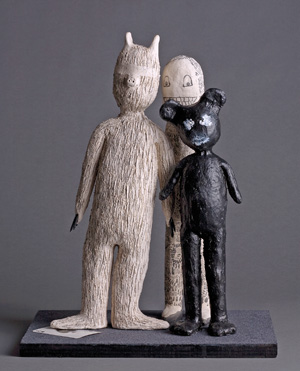MELISSA STERN ’80: OFF-BALANCE ART
Dark yet comic, portraying strength yet vulnerability, Melissa Stern’s art negotiates the tensions inherent with each step we take—a willingness to fall down and a confidence that we’ll regain balance.

Photo: Alison Rosa.
It is worth taking the time to get beneath the surface of Melissa Stern’s art. On first glance at her drawing “Wolf Dancer,” for instance, you see a shadowy black figure, balanced en pointe on the back of a gray wolf whose triangle face is looking right at you. On closer inspection, you become aware of white lines surrounding the dancer, animating the figure so it looks as if it will begin to twirl right in front of your eyes, moving from two dimensions to three. As you gaze at the enigmatic image, you see that the background itself is deeper than you realized at first, with a rich patina of white, black and gray that allows the figures to float in a mysterious, cloudy space. The traces of what is hidden in Stern’s work are as essential as what is revealed.
She spends hours preparing the paper on which she will work, priming it with layers of pigment called gesso. “I will take seven-foot-long pieces of paper and gesso them, and then I’ll draw in it, and then I’ll gesso it again and gesso it again,” Stern says. “I don’t think you can consciously see that in the drawings, which is part of the reason I do it, but it’s there, and all the past drawings and all the past marks are back there. So that’s hours and hours of prep work. It’s creating the drawing behind the drawing.” This preparation is her practice, orienting her to the work that follows. Before she even begins to draw, the paper is layered with history, like the layers of memories that lie beneath the surface of our lives, informing and affecting our current experiences.
“History is one way to put it,” says Meg Shiffler, who is the galleries director at the San Francisco Arts Commission. “I think she likes to dirty up her work; it’s very cheeky the way she works the surfaces.” Shiffler has followed Stern’s work for almost 20 years, and when she uses the word “dirty,” it has many connotations. She describes Stern’s work as “a little naughty and unprecious…she has an incredibly consistent voice, whether working in clay or drawing or collage work, a very signature look.”
Stern works in her studio in New York City, a tall, spacious room with a wall of windows that face south. Over the course of an afternoon you can watch sunlight arc across a tangle of plants near the window; tables and desks covered with found materials, finished sculptures, brushes, and books; a beat-up white glass-fronted cabinet that holds several hundred old LIFE magazines that Stern cannibalizes for her collages; as well as her stereo and thousands of mixtapes she’s made of radio shows from the past 20 years. “I love the live sound,” she says, “the little person in the box talking to me. The moment I walk into the studio, I put music on.” Her art is visual, but Stern’s world is rarely silent.
Her latest sculptures aren’t silent either. In 2012 she created a series of work she called The Talking Cure, which was exhibited in Seattle and New York City. Inspired by Sigmund Freud’s description of psychoanalysis, The Talking Cure included 12 sculptures that will seem familiar to anyone who has seen Stern’s work. Each is a human figure reduced to essentials. Some lack even those: One face has no features; one torso has a single arm. Figures are caught mid-gesture, as if about to leap beyond the plinth or reach up to grab you. Made of clay, their surfaces layered with paint and wax and sometimes lead or concrete, almost all of the figures are off balance. But they stand. Without being bolted to the floor.
“They all look like they could fall down at any moment,” Stern says, “and the secret is that they never do. That’s part of what I’m saying about them as people, if you will… there’s this precariousness that one could put into psychological or emotional terms. We’re all about to fall down, and we don’t, or they don’t. The idea is of balance and counterbalance, and this sense that many of them look like they’re about to take a step… they’re frozen in that moment of movement.” Many of the figures carry burdens that further push them off center. One is chained to a lead weight on the floor; two others are tied together, back to back; a third has a hole where her heart should be, filled with a reflective steel ball.
People often ask Stern what her sculptures mean, and her standard response, like a therapist’s, is, “What do you think it means?” With The Talking Cure, she took that a step further. After creating the sculptures for the show, Stern asked 12 writers to choose a sculpture and develop an interior monologue for their character: “To write in the voice of the piece,” she says. She then recorded actors delivering the monologues, and visitors to the gallery were able to listen via QR codes for their smart phones, or on a recording. Her dark, funny and primitive figures had found their voices.
“That’s part of the strong tie to narrative,” Stern says. “You’re seeing them almost like a film still, in a moment between other moments, seeing them in the middle of a story, and that is what led me to the idea of The Talking Cure. My work has always

been very narrative in a more abstract sense. They’re always in the middle of a story, and I thought it would be an interesting experiment to see what people thought those stories are.” The addition of voice emphasizes the sense of each figure being caught in a moment between moving and falling down.
On a cloudy winter afternoon, I visited The Talking Cure in a gallery in Lower Manhattan. A nearby elementary school had just let out, and Lorenz, a fourth grader, and his mother, Maria, wandered into the gallery and put on headphones to listen. Lorenz was entranced by the sculptures; he loved that he could hear what they were thinking. “When they are talking,” he told me, “you can really see how they feel.”
Lorenz’s favorite sculpture was a group of three figures, called Friends. Their story was written by screenwriter and Stern’s longtime friend Janet Grillo ’80, who says that Stern’s work is so evocative, “It’s like a psychological x-ray.” Grillo chose this sculpture because she was drawn to the relationship between the characters, which she imagined to be a husband and wife and the husband’s uninvited friend.
“When you have a cluster of people, and their feeling states are obvious, you wonder what the dynamic is that stimulated this feeling state,” Grillo says. “It’s like a loop going around. She’s doing this so she is feeling that; she’s doing this so he does that. The reaction that the female character is having to this turn of events; she’s reacting and trying to both interpret, accommodate and manage her own distress over being replaced by this guy’s own shadow.” Grillo’s story adds a layer to the sculpture, further solidifying it into a narrative that might not have been what you would expect of the three odd figures, one furry, one bear-like, one with a manic grin. As you listen, they become a wounded couple with a third, unwelcome dark presence.
The monologue begins, “Of course I like him, why wouldn’t I like him? He’s adorable.” [You can listen to the whole monologue by capturing the QR code underneath the photograph with your cell phone.] Grillo exposes the essence of this unlikely trio, revealing that both the husband and wife are missing something vital—one has no eyes or mouth, the other no ears, only the shadow has all its essential features. The monologue ends with a lament: “Why have you dealt us this strange, dark, shadow of a fellow, who gets to see what you won’t. And hear what I can’t.”
Like many artists, Grillo drew on her own experience as she wrote the characters’ thoughts. “I lived for many years with a man who struggles with mental illness,” she says. “So this was deeply personal for me.

Because I could see literally, and actually, that something was very wrong, and he couldn’t, or intermittently could. And it can never get fixed, you’re just reacting to it and managing it and accommodating it. But it just grows. This little dark fellow just grows and grows and grows until he has devoured the relationship.”
The monologues for each of the other sculptures plumb similarly fraught, emotional depths for the characters. “My pieces evoke strong emotions, and maybe strong mixed emotions,” Stern says. “My work has always been funny and dark at the same time. When it’s good, that’s what touches people.”
Gallerist Meg Shiffler notes that Stern’s work with clay requires a lot of strength. “There’s a physicality to Stern’s practice; she’s small but she’s a strong woman in the studio…She’s not a timid person, yet her strength is balanced with a vulnerability. When you meet her she seems at once strong and vulnerable, and it’s the first thing that hits you when you see her work: The strong lines and figures are also vulnerable and exposed and painful. She’s one of those trained artists who is very intuitive and creates intuitively; she is an artist who creates from the gut in the way that outsider artists do.”
Stern says she knew she wanted to be an artist when she was a little girl: “My whole life, I made things.” Her mother was a commercial artist who painted at night, her father was a history professor. In high school Stern dreamed of going to art school, but her father felt strongly that she should get a good liberal arts education. “He said, ‘If you want to be an artist, learn about the world. Learn about history, learn about science, learn about religion, learn how to write.’ The greatest gift he ever gave me was to force me into that.” At Wesleyan she worked in the Davison print collection, spent hours creating her art, and majored in anthropology. “I studied why people make things. I tell people that anthropology is the best thing to major in if you want to be an artist.”
At Wesleyan Stern also met her husband, Jim Friedlich ’79. They live in an apartment on the same floor as her studio. The hallway in between is filled with the familiar detritus of family life, shoes and newspapers, and some less familiar things. On a long shelf sit 17 chairs, sculpted from clay, wood, found objects—one is even made of doll parts. At the entrance to Stern and Friedlich’s apartment, you’re greeted by a jolly three-foot-high sculpture of a man who has stabbed himself all over with butter knives; they still poke out of his round belly. To the left of the dining table, a 10-foot-high figure lifts his own head off his shoulders.
“People asked if I was ever scared of them growing up,” says their son Max Friedlich, a member of the class of 2017 at Wesleyan. “It’s like having a fourth person in the house. They’re dark but there’s a humor to them.” Max, who writes plays (his Sleepover was performed at the New York International Fringe Festival last summer), says that he’s learned a lot about what it means to live a creative life from watching his mother weather the ups and downs of pursuing her art. “She’s never quit, and she’s had tons of reasons to quit…she just has incredible durability artistically. She always keeps going and keeps creating as an artist. I’ve experienced minor degrees of rejection and disappointment. She never gives up, she teaches by example, and that’s one of the more important lessons she’s given me: As an artistic person you just have to keep going.”
As a child, Max would spend hours after school in his mother’s studio while she worked, walking around, making up stories. When Stern asked him to write a monologue for one of the sculptures in The Talking Cure, he chose Dance, a lithe black figure with legs and arms akimbo, feet tied with red ribbons to huge blocks of what looks to be concrete. “I liked the contrast of it,” Max says, “how skinny the figure is in sharp contrast to how clunky and large the blocks are.” The character Max created is a young man waking up and remembering a girl he’s lost. The monologue ends, “Is she my anchor or my weight? I’m learning how to walk with it but she will always be there for the world to see.”

Photo: Alison Rosa.
In his monologue Max has captured the anguish beneath the smooth surface of the sculpture and its crudely drawn features. This figure is balanced on blocks as if walking a tightrope. He seems just moments from falling down. “I think being willing to fall down is an important thing in being an artist,” Stern says. “That assumes that you believe you’ll be able to get yourself back up again.” In The Talking Cure, Stern beautifully captures the state we all experience as we move through our lives, negotiating the tension of being off balance, almost falling, almost lurching forward, constantly shifting to keep ourselves upright. Through the layers of pigment, the sensuous surfaces, and the melodies of each sculpture’s interior monologues, Stern and her collaborators have created a multi-sensory experience that give us a chance to reflect on the rich strata of our own lives.


